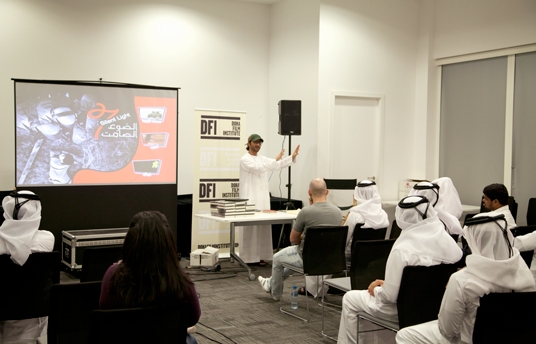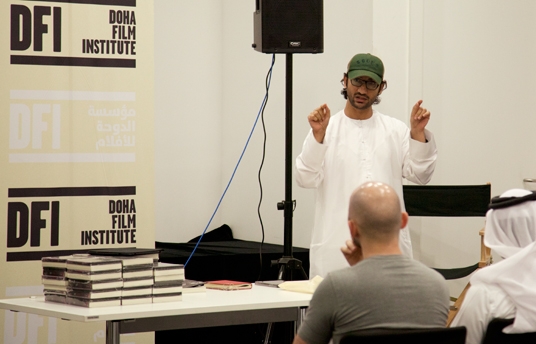خمس خطوات لصناعة فيلم قصير
05 سبتمبر 2012

_ تجميع أنيلا صفدار، قسم الويب، مؤسسة الدوحة للأفلام_
أنهى نحو 50 مشاركاً ورشة طواش الأفلام – التي استمرت 4 أيام، ودارت حول كيفية إنتاج الأفلام القصيرة.
وقامت وحدة تمويل أفلام الخليج التابعة لمؤسسة الدوحة للأفلام بتنظيم هذه الورشة بقيادة المخرج الاماراتي عبدالله حسن أحمد، وفيها، تمكن الطلاب من تحليل أربعة من أفلامه القصيرة، بدءاً من النصوص السينمائية وصولاً إلى الأعمال على الشاشة: “تنباك“، “صورة ناقصة“، “سبيل” وأصغر من السماء”.
هل باتت لديهم فكرة عن صناعة أفلام قصيرة خاصة بهم؟
لهذا الغرض، سألناهم عن الخطوات الخمس الداخلة في صناعة الفيلم القصير:
1. مرحلة ما قبل الانتاج

Nada Al Saadi
ندى السعدي، 25 سنة، مصممة غرافيكس في الجزيرة
“ مرحلة ما قبل الانتاج هي مرحلة التحضير، والتحضير ثم التحضير. يجب أن تكون منظماً لكي تفتح المجال للابداع لاحقاً.
تشمل هذه المرحلة العثور على مواقع التصوير، والممثلين. عملية الكاستينغ (اختيار الممثلين) في الدوحة قد تكون صعبة جداً، كما أن العثور على ممثلين عملية أكثر صعوبة. ليس لدينا مجموعة كبيرة كي نختار منها. يجب أن تقوم بذلك مسبقاً كي توفر الوقت. يجب أن تتأكد من أن الممثلين ملتزمين معك كي لا يعتذر أحدهم في الدقيقة الأخيرة. هذا مفتاح لبناء العلاقات.
العثور على الموقع قد يكون أمراً محيراً. هنا، نحن بحاجة لاستصدار تصريحات للتصوير في كل مكان. وهذه عملية تتطلب وقتاً، وقد نضطر للاتصال ببعض المعارف والوساطات لتسييرها.
2. الانتاج
ريم طلال، 23 سنة، طالبة إعلام في جامعة قطر
“تشمل مرحلة الانتاج عملية تنظيم الميزانية، وبرنامج التصوير اليومي، وتنظيم المعدات والتأكد من تنفيذ كل ما تم التحضير له في مرحلة ما قبل الانتاج. ويجب أن يلتزم فريق التصوير بالجدول الموضوع، وألا يحدث تأخير كبير.
الأشخاص البارزون في هذه المرحلة هم مدير الانتاج، المنتج، المنتج المساعد، السائق والمساعد.
وفي هذه المرحلة، يجب على المخرج أن يحرص أن الجميع يقوم بدوره على أكمل وجه، وأن يراقب عملية الانفاق والتزامها بالميزانية.
3. مرحلة ما بعد الانتاج
طيبة غدي، 31 سنة، مونتيرة متعاونة
“مرحلة ما بعد الانتاج تشمل عملية التجميع.
يهتم الممنتجون بشكل الفيلم والصوت، وهذا يشمل تصحيح الألوان، وإضافة المؤثرات البصرية وهندسة الصوت.
إذا كانت مدة الفيلم 15 دقيقة، قد تمتد ههذه المرحلة على فترة تتراوح ما بين 4 ساعات إلى أسبوع واحد، وفقاً لعدد المشاكل التي ستطرأ. أحياناً نضطر إلى إعادة تصوير المشهد، إذا كان مفقوداً أو ناقصاً، علماً أنه يجب أن نحاول إيجاد حلول بديلة في مرحلة ما بعد الانتاج.
إنه الوقت الذي يجب أن تعثر فيه على الحلول. وتحتاج هذه المرحلة الكثير من الصبر والتركيز. المونتير قد يجلس في غرفة المونتاج 10 ساعات. أحياناً قد يأتي المخرج ويتناقش معه، لذا يجب أن يعرف ما هو مطلوب منه.
4. المطبوعات

Hamza Rustom
حمزة رستم، 24 سنة، فني أشعة
“حين نقوم بعملية الطباعة، علينا ألا ننسى نوع الفيلم المستخدم. قد يختلف شكل الفيلم من مهرجان إلى آخر- بعضها قد يطلب أن نرسل له الفيلم على شكل بكرة.
وتشمل مرحلة المطبوعات عملية التسويق للفيلم، التي تشملها الميزانية الموضوعة له. يجب أن تعمل مع مصمم غرافيكس كي تصمم بوستر للفيلم.
هناك طرق حديثة كثيرة للتسويق، كاللجوء إلى وسائل التواصل الاجتماعي التي تستطيع أن تصل عبرها إلى جماهير المشرق والمغرب.
تتطلب هذه المرحلة وضع الاستراتيجيات وهي من اختصاص المنتج.”
5. المهرجانات

Abdallah Al Kuwari
عبدالله الكواري، 16 سنة، طالب في مدرسة خليفة المستقلة
“تسمح لنا المهرجانات بعرض أفلامنا كي يراها الناس؛ ويجب أن تكون مستعداً لسماع آراء الناس.
تقوم بإرسال فيلمك عبر الموقع الالكتروني للمهرجان، وتنتظر ليصلك خبر قبول أو رفض مشاركة فيلمك.
حتى لو لم يتم اختياره للمشاركة في المنافسة، قد يتم عرضه في المهرجان.
في هذه المرحلة يجب أن تتحلى بالهدوء. يجب أن تستعد للرفض. إذا لم يتم قبولك، استمر بالمحاولة مع مهرجانات أخرى. لا تستسلم. قد لا يفهم الجمهور أهمية فيلمك، وقد تضطر لتشرح لهم هذه الأهمية.
